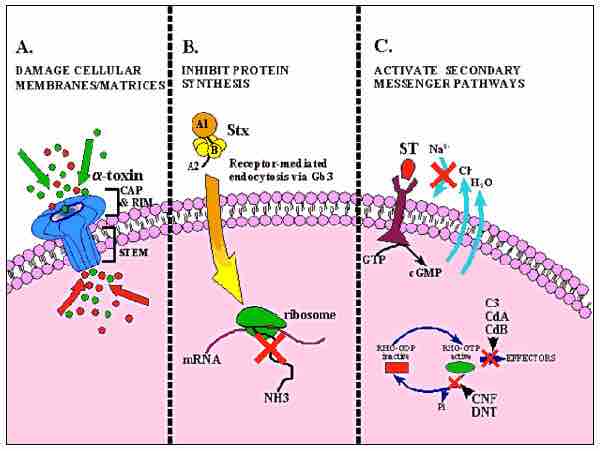Toxins are poisonous substances produced within living cells or organisms and can include various classes of small molecules or proteins that cause disease on contact. The severity and type of diseases caused by toxins can range from minor effects to deadly effects. The organisms which are capable of producing toxins include bacteria, fungi, algae, and plants. Some of the major types of toxins include, but are not limited to, environmental, marine, and microbial toxins. Microbial toxins may include those produced by the microorganisms bacteria (i.e. bacterial toxins) and fungi (i.e. mycotoxins).
Bacterial Toxins
Bacterial toxins are typically classified under two major categories: exotoxins or endotoxins. Exotoxins are immediately released into the surrounding environment whereas endotoxins are not released until the bacteria is killed by the immune system. The release of toxins into the surrounding environment, regardless of when released, results in the disruption of metabolic pathways in the host eukaryote . These metabolic pathways include damaging cell membranes, disrupting protein synthesis, inhibiting neurotransmitter release, or activating the host immune system. The mechanisms of action by which toxins disrupt eukaryotic cell processes are dependent on the target. For example, the bacteria Listeria monocytogenes, associated with food-borne illnesses, specifically targets cholesterol by producing a pore-forming toxin protein, listeriolysin O. This exotoxin affects intracellular processes and creates unregulated pores within the cell membranes of the host. Another example of an exotoxin includes an enterotoxin produced by the bacteria Staphlycoccal aureus. S. aureus can producestaphylococcal enterotoxin B (SEB), associated with intestinal illness, which promotes activation of the immune system. Upon activation of the immune system, the release of large amounts of cytokines, inflammatory related molecules, causes significant inflammation. Lastly, an example of an endotoxin, includes the protein lipopolysaccharide (LPS) produced by gram-negative bacteria. The LPS is a component of the bacteria's outer membrane and promotes structural integrity. Upon destruction of the membrane by an immune response, the LPS is released and functions as a toxin.

Bacterial Toxin Mechanism of Action
A schematic of various processes utilized by bacterial toxins to damage host cells.
However, bacterial toxins are also currently serving as new sources for potential drug development. Toxins have been shown to exhibit anticancer characteristics and fight again microbial virulence. The investigation of toxins as potential medicinal compounds is currently underway.
Mycotoxins
Mycotoxins are the classes of toxins produced by fungi. Mycotoxins are numerous and production of a specific mycotoxin is not restricted to one specific species. Mycotoxins are secondary metabolites that are toxic to humans and produced by fungi. There are various types of mycotoxins including, but not limited to, aflatoxins, ochratoxins, citrinin, and ergot alkaloids.
Aflatoxins
Aflatoxins are a type of mycotoxin that are produced by certain strains of Aspergillus fungi. The aflatoxins are further broken down into types: AFB1, AFB2, AFG1, and AFG2. These strains are present in a wide range of agricultural commodities associated with tropic and subtropic zones. These commodities include species of peanuts and corn. The most potent toxin is AFB1 and it is associated with carcinogenic effects.
Ochratoxin
Ochratoxin is a type of toxin produced by both Penicillium and Aspergillus species. Ochratoxins are further classified in types A, B and C and differ in structure. Ochratoxins have demonstrated carcinogenic properties and are often found in beverages such as beer and wine, as the fungal species which produce ochratoxins are often found on the plants used to produce these products.
Citrinin
Citrinin is a mycotoxin that has been isolated in numerous species of both Penicillium and Aspergillus. Many of these fungal species are utilized in food processing and are often found in foods including cheese, wheat, rice, corn, and soy sauce. Citrinin is known to function as a nephrotoxin, indicating it has toxic effects on kidney function.
Ergot Alkaloids
Ergot Alkaloids are specific compounds that are produced as toxic alkaloids in Claviceps, a group of fungi associated with grasses, rye, and related plants. The disease caused by ingestion of this fungi is called ergotism. Ergotism is characterized by detrimental effects on the vascular system in particular, including vasoconstriction of blood vessels resulting in gangrene, and eventually, limb loss if left untreated. Additionally, ergotism can present as hallucinations and convulsions as ergot alkaloids target the central nervous system. Due to the vascular system effects of ergot alkaloids, they have been used for medicinal purposes.